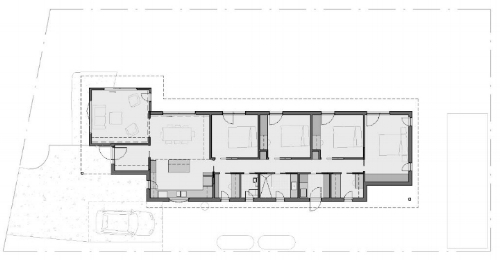Star Ratings & Passivhaus
Last week I attended the inaugural Australian Residential Energy Rating Conference hosted by CSIRO and the Nationwide House Energy Rating Scheme (NatHERS) in Melbourne. NatHERS is the industry standard software used in Australia to generate star ratings for houses. One of the main aims of the conference was to “discuss the issues that will support the delivery of affordable and high-performing houses for the Australian community, both now and into the future”.
Among many excellent presentations, there was one about the Passive House standard (German Passivhaus) and Passivhaus was mentioned several times during the conference. Notably, nobody discussed how the Passivhaus Planning Package (PHPP) standards compare to a NatHERS star rating in terms of predicted energy use. [NB. I prefer to use the German spelling to avoid confusion between it and solar passive house design - that’s for another blog – so excuse me for sticking with Passivhaus here.]
Passivhaus is being discussed a lot in the broader Australian design and construction industry and many architects, builders and members of the public are excited about it, almost as if it’s the very first time building physics has been used to inform house design in Australia. It isn’t.
NatHERS software is a powerful, building physics simulation tool, developed here in Australia by CSIRO (and its predecessors) over the last several decades. In most parts of the country, all new homes have to meet a minimum NatHERS 6 star standard to be approved for construction. The software predicts the annual heating and cooling load for your particular design, with its particular construction details and specifications, in its particular part of Australia (currently 69 different zones in the software). The 'Chenath' engine that the NatHERS software uses is highly respected internationally. For more details about Passivhaus and NatHERS software see the dedicated websites of the Australian Passive House Association, NatHERS and CSIRO Energy Rating. At Light House we use NatHERS accredited software BERS Pro.
In this article, I want to boil things down to a simple comparison of the Passivhaus standard and the predicted heating and cooling loads from NatHERS and outline a couple of case studies that show what can be achieved in Australia (more specifically Canberra) with a more standard approach, using readily available tools, materials, and methods.
First, some personal background: I learned about air barrier technologies and Passivhaus in 2009 when I was doing my air leakage testing training with ProClima in Wellington New Zealand and at the Energy Centre University in Wisconsin. I came back from these trips armed with samples of smart air barrier membranes, copious notes about the Passivhaus approach and a desire to transform residential construction (having lived in my share of typical Australian houses). I had also recently completed my training as a NatHERS assessor. For the last nine years, I have worked in the Canberra housing industry – with architects and builders, industry associations and local government. I have tested and optimised hundreds of designs using NatHERS software, physically tested over 200 hundred homes using a blower door and thermal camera and run a company that has completed more than 80 projects (roughly one third renovation/extensions and the remainder new builds) all focused on the most cost-effective way of achieving high levels of energy efficiency and comfort; features that go hand in hand with occupant health and building durability.
Passivhaus standard energy requirements (as predicted in PHPP)
Heating <= 15 kWh/m²/year
Cooling <= 15 kWh/m²/year
A total combined heating and load of not more than 30 kWh/m²/year, independent of climate zone.
30 kWh = 108 MJ => an accredited Passivhaus can have a maximum total combined heating plus cooling demand of up to 108 MJ/m²/year.
**NatHERS software expresses predicted energy requirements in MJ/m²/year and uses the combined heating and cooling load to assign the house design a star rating. The rating is climate specific. The software identifies 69 different climate zones across Australia.
108 MJ is equivalent to a 7.3 star NatHERs design in Canberra, and a 6.4 star NatHERS design in Melbourne.
Passivhaus standard airtightness requirements
0.6 air changes per hour in a building positively pressurised to 50 Pascals.
I completely agree with Passivhaus when they say: In a leaky building, air infiltration can account for as much as 50% of the heating and air conditioning loads, and accounts for most of the discomfort due to draughts or excessive heat gains.
A recent study by CSIRO of 129 houses found an average air leakage rate of 15.4. In my experience, Canberra homes are, on average, more like 20 ACH@50Pa (some are over 30). The NatHERS software assumes an air leakage rate of 10-12 ACH@50Pa.
7.5 to 8.5 stars is the sweet spot
Several researchers at the conference in Melbourne noted that it was most cost-effective to be aiming for 7.5 to 8.5 star homes in Australia.
An 8 star design in Canberra is predicted to require 77 MJ/m²/year for heating and cooling.
An 8 star design in Melbourne is predicted to require 54 MJ/m²/year for heating and cooling.
Light House Case Study 1 - built in Canberra in 2013
Floor plan of Case Study 1 House. Long axis east-west. North to the side (upwards).
Floor area & rooms: 152 m², 3 bedrooms, 2 living areas, 1 bathroom, 2 studies
Construction: concrete slab on ground, timber frame, mix of brick veneer and lightweight cladding, metal roof
Insulation: R0.77 to underside of slab (225mm waffle pods), R1 to vertical edge of slab, R2.5 batts to external walls, R1.5 to internal walls, R5 batts to ceilings
Moisture control: vapour permeable wrap to outside of timber frame in walls and roof, externally ducted exhaust fans to wet areas
Ventilation: all windows openable for planned cross ventilation
NatHERS star rating: 8.5
Residents: 2 adults, 2 children
Air leakage rate: 8 ACH@50Pa
Glazing: uPVC double
Energy source: all electric, no gas
Heating: 3.5kW split system
Cooling: ceiling fans throughout, occasionally split system
Hot Water: evacuated tube solar
Total actual energy use (heating, hot water, and all domestic electricity): 12 kWh/m²/year - a quarter of the allowable total energy use of an accredited Passivhaus.
Energy generation: 4kW photovoltaic (PV) system, generates much more energy than household consumes.
Average daily electricity consumption at Case Study 1 House from December 2013 to February 2015 & comparison of the household's electricity usage with other households in the area (NB. many of the comparison households also use gas for heating, hot water and cooking so the total energy consumption of the comparison households would actually be even higher).
Light House Case Study 2 - built in Canberra in 2017
Floor plan of Case Study 2 House. Long axis north-south. North to the street (to the right).
Floor area & rooms: 150 m², 4 bedrooms, 2 living areas, 2 bathrooms
Construction: concrete slab on ground, timber frame, mix of brick veneer and lightweight cladding, metal roof
Insulation: R1 to underside of slab (Cupolex construction), R1 to vertical edge of slab, R2.5 batts to external walls, R1.5 to internal walls, R5 batts to ceilings
Moisture control: vapour permeable wrap to outside of timber frame in walls and roof, externally ducted exhaust fans to wet areas
Ventilation: all windows openable for planned cross ventilation, 3 decentralised HRV pairs (bed1-bed2, bed3-bed4, dining-living) used only in the depths of winter
NatHERS star rating: 8
Residents: 2 adults, 2 teenagers
Air leakage rate: 3.4 ACH@50Pa
Glazing: uPVC double
Energy source: all electric, no gas
Heating: 2 x 600W infrared panels in bathrooms, Ventis sub-flow system that pumps hot air from the roof space into the sealed air void beneath the Cupolex dome slab (under controlled temperature and humidity conditions)
Cooling: ceiling fans only
Hot water: heat pump
Total actually energy use (heating, hot water, and all domestic electricity): 31 kWh/m²/year - one third less than the allowable total energy use of an accredited Passivhaus.
Energy generation: the owner's 3kW portion of the new SolarShare community solar farm will generate enough to cover usage.
Average daily electricity consumption at Case Study 2 House from March 2017 to February 2018 & comparison of the household's electricity usage with other households in the area (NB. many of the comparison households also use gas for heating, hot water and cooking so the total energy consumption of the comparison households would actually be even higher).
***Light House homes perform better than the NatHERS modeling suggest because they are more airtight than the assumptions made by the modeling, typically between 4 and 8 ACH@50Pa (that’s up to 3 times better than NatHERS software assumes and 5 times better than your average Canberra home). This level of tightness is achieved without the use of internal air barrier membranes. At this level of airtightness, heat recovery ventilation (HRV) is not required.
In Summary
I am not anti-Passivhaus. In fact, I am a fan of many of the excellent technologies, materials and products used by Passivhaus (I have three small decentralised HRV systems in my own house and smart humidity sensing exhaust fans in the bathrooms). However, I have learned over the last nine years that, in houses, we can achieve levels of performance equal to the Passivhaus standards of energy use, with tools that are readily available to the mainstream housing industry. I know this because I’ve overseen the design and build of such houses, testing them before, during and after construction. We don’t use internal air barrier membranes, triple glazing or rely on heat recovery ventilation but we do carefully design and build high-quality, appropriately-ventilated building envelopes suited to their local climate and test that our homes are built as designed and specified.
If we are serious about affordability, then this needs to be discussed. Long-term cost tracking in Europe (where the technologies and methods required for Passivhaus construction are much more readily available) shows that Passivhaus projects are likely to require 3-8% more in upfront costs. My experience, seeking cost estimates to convert some of our projects to being Passivhaus compliant, suggests the difference is significantly bigger in Australia.
Whichever path you take, great design for your local climate + a well-insulated and sealed building envelope + appropriate ventilation are the keys to a comfortable, healthy and energy efficient home. A bit of architecture + science can go a long way! There are 600 accredited or licensed NatHERS assessors in Australia. Enlist their help at the start of the design process and you can actually save yourself money upfront on the build, in addition to the significant savings on running costs over the lifetime of your home. There are also quite a few companies around Australia offering air leakage testing and thermal imaging services, and lots of builders interested in, and capable of, constructing high-quality building envelopes.
Passivhaus is an important new approach in the Australian housing industry. It has helped bring the importance of the building envelope - thorough insulation, airtightness, control of moisture and condensation, appropriate glazing and ventilation - to the forefront of discussions about energy efficiency, thermal comfort, occupant health and building durability. However, it is only part of the picture. In the Australian residential sector there are simpler and more affordable ways to achieve similar results, even in the colder climates like that of Canberra.
Jenny Edwards, Managing Director at Light House Architecture & Science
References/Further Reading
Australian Residential Energy Rating Conference, 2018
CSIRO Energy Rating Research - history
Measuring buildings – Air-tightness of new house construction, 2016
Australian Passive House Association
Nationwide House Energy Rating Scheme (NatHERS)
SolarShare community solar farm
Passive Solar Design : Passive House 101
House Energy Efficiency Inspections Project, 2015
Chifley Passive House: a case study in energy efficiency and comfort, 2017
National Energy Efficiency Building Project, 2014
The Bottom Line – household impacts of delaying improved energy requirements in the Building Code
ACT Outreach Energy and Water Efficiency Program - Case Study Report, 2013






